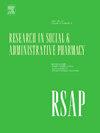新程序理论在药剂师主导的病人为中心的药物审查在全科实践-定性试点研究。
IF 2.8
3区 医学
Q1 PUBLIC, ENVIRONMENTAL & OCCUPATIONAL HEALTH
Research in Social & Administrative Pharmacy
Pub Date : 2025-07-11
DOI:10.1016/j.sapharm.2025.07.002
引用次数: 0
摘要
背景:药剂师越来越多地参与全科实践,以促进合理处方和减少工作量。为了进一步改善患者的预后,我们建立了一种新的以患者为中心的药物评价(MR)模型,用于多药患者的初级保健。这种模式包括患者与药剂师进行最初的“问题检测会议”,并与药剂师和全科医生(GP)讨论核磁共振结果。目的:对新的MR模型进行试点测试,以补充现有的程序理论。方法:在丹麦的两个一般实践中,对MR模型进行定性描述性非参与性观察,以确定背景因素并确定如何实施干预。对全科医生、患者和药剂师进行半结构化访谈以确定结果。通过现实主义评价原则,推断出情境、干预和结果之间的联系机制。结果:新模式提高了患者和全科医生的满意度。三个核心机制是:1)药剂师和全科医生对MR工作的理解一致;2)关系工作投入;3)灵活性,使该模式能够满足全科医生的需求,尽管他们在综合药房的经验、工作方式和入组患者的知识方面存在差异。结论:新模式说明药师如何支持全科医生。新的程序理论认为,药剂师和全科医生之间兼容的观点在适当的多药工作中的重要性,即“共享的心理模型”,全科医生在与药剂师互动时发展他们的心理模型的方式,以及当模型冲突时关系工作的有用性。本文章由计算机程序翻译,如有差异,请以英文原文为准。
New program theory in pharmacist-led patient-centered medication review in general practice: A qualitative pilot study
Background
Pharmacists are increasingly engaged in general practice to contribute to rational prescribing and to reduce the workloads. To further improve patients' outcomes, a new patient-centered medication review (MR) model in primary care for polypharmacy patients was developed. This model involves patients in an initial ‘problem detection meeting’ with the pharmacist and in a meeting with the pharmacist and the General Practitioner (GP) to discuss MR findings.
Objectives
To pilot test the new MR model to supplement existing program theory.
Methods
Qualitative descriptive nonparticipatory observations of the MR model were carried out in two general practices in Denmark to identify Context elements and determine how the Intervention was enacted. Semistructured interviews with GPs, patients and the pharmacist were conducted to establish Outcomes. Through principles of realist evaluation, Mechanisms, i.e., links connecting Context, Intervention and Outcomes, were inferred.
Results
The new model led to satisfaction among patients and GPs. Three central mechanisms were: 1) alignment between the pharmacist and the GP in their understanding of MR work; 2) investment in relational work; and 3) flexibility, allowing the model to fulfill the needs of GPs despite differences in experiences with polypharmacy, working styles, and knowledge of enrolled patients.
Conclusion
The new model illustrates how pharmacists can support GPs. New program theory regards the importance of compatible perspectives between pharmacists and GPs on appropriate polypharmacy work, i.e., ‘shared mental models’, the ways GPs can develop their mental models when interacting with pharmacists, and the usefulness of relational work when the models clash.
求助全文
通过发布文献求助,成功后即可免费获取论文全文。
去求助
来源期刊

Research in Social & Administrative Pharmacy
PUBLIC, ENVIRONMENTAL & OCCUPATIONAL HEALTH-
CiteScore
7.20
自引率
10.30%
发文量
225
审稿时长
47 days
期刊介绍:
Research in Social and Administrative Pharmacy (RSAP) is a quarterly publication featuring original scientific reports and comprehensive review articles in the social and administrative pharmaceutical sciences. Topics of interest include outcomes evaluation of products, programs, or services; pharmacoepidemiology; medication adherence; direct-to-consumer advertising of prescription medications; disease state management; health systems reform; drug marketing; medication distribution systems such as e-prescribing; web-based pharmaceutical/medical services; drug commerce and re-importation; and health professions workforce issues.
 求助内容:
求助内容: 应助结果提醒方式:
应助结果提醒方式:


